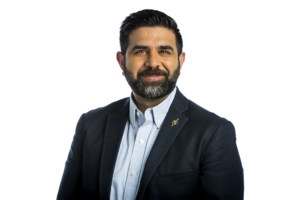Keck School of Medicine of USC chief research informatics officer plots a path for digital innovation
By Wayne Lewis
Data scientist Neil Bahroos, MS, MBA, joined USC in 2020 with an impressive résumé, highlighted by work on the Human Genome Project, innovative industry experience, and a track record of helping medical centers use abundant data to transform their research and treatment programs. As the Keck School of Medicine of USC’s first-ever chief research informatics officer, he’s determined to be an enabling force for science that makes an impact on human health.
Bahroos, who is also an associate professor of research in preventive medicine, recently shared his thoughts about the challenges of large amounts of data, the potential of biomedical informatics, and why you don’t always have to dress for the job you want.
For the uninitiated, what do we mean by “informatics”?
Over the last three decades or so, data has grown exponentially. That’s awesome, but it’s also created more haystacks where “needles” of information can hide. There’s this “DRIP” idea—we’re data-rich but information-poor.
We’re trying to get at knowledge, and informatics is the recipe for extracting knowledge from data.
You’ve built successful biomedical informatics programs at the University of Chicago, the University of Illinois at Chicago, and the Shirley Ryan AbilityLab. Can you give an example of the difference your work has made?
When I got to Shirley Ryan, they had already been the country’s No. 1 rehabilitation hospital for a long time. They wanted to take their hands-on approach and make it data-driven. I led the development of a predictive analytics platform for patient outcomes, based on decades of patient data. They were able to put this research-based advanced analytics platform into practice directly in care settings.
Care teams held weekly team conferences where they deliberated about each patient. With the system I helped set up, teams were able to utilize the power of predictive analysis live, right there in the meetings. They could pose different scenarios and see a graph moving, with predictions about length of stay and other ways to measure outcomes. Then, the results of their decisions get turned into feedback for machine learning, which informed them at the next meeting. The end result was better and more efficient care.
Being the key person to apply data as knowledge for individual cases—that’s the kind of experience that fuels my passion for my work. The idea at USC is, wouldn’t it be great to take this beyond rehab and do it at a full-fledged academic medical center?
What’s your vision for biomedical informatics at the Keck School?
There’s an analogy to a good public transit system, where stops are convenient so that commuters can get anywhere and everywhere. All they have to worry about is their first mile and their last mile to and from their home.
In a similar way, when someone has a light-bulb moment — “Wouldn’t it be great if …?” — I want to create that great system in between, so they can take that idea and execute on it. It’s looking at how to capture and manage data; which data scientists, advanced analytics and applications are needed; and perhaps how it can feed into a clinical intervention.
So if someone at the Keck School of Medicine has an idea at the design phase (the first mile), they can engage our system to access and analyze data. Then we let them off the train so they can accomplish their last mile, which might be a publication or a health innovation.
We can become a learning health system with a data-driven approach, coupled with ingenuity, innovation and insight. I’d like to lower the cost of discovery and create a digital laboratory for our brilliant scientists and clinicians.
How did you first get into the field?
Back around 1993, I had built up a background in genetics and biochemistry as well as computer science, and I was looking for the next thing to do. But I didn’t have that in mind when I went along with a friend who was attending a job fair at a hotel in Toronto, where I’m from. I was just going to hang out in the lobby, so I was in a tie-dye shirt, shorts and a cap.
My friend was doing interviews, and they came down and said, “There’s somebody you’d like to meet.” I was like, “What are you talking about?”
So I went up to this room. Keep in mind, everyone else was wearing suits, so I didn’t fit in at all. I met this guy from Sick Children’s Hospital who said, “Your friend told us all about you, and you’re the type of person we’re looking for.” They were doing this thing called “bioinformatics,” which was just being coined at that time. I ended up working at Sick Children’s on the Human Genome Project, decoding chromosome seven.
Once I found informatics, this was my thing. From there, I moved more and more into clinical research informatics, and that’s where we are today.
